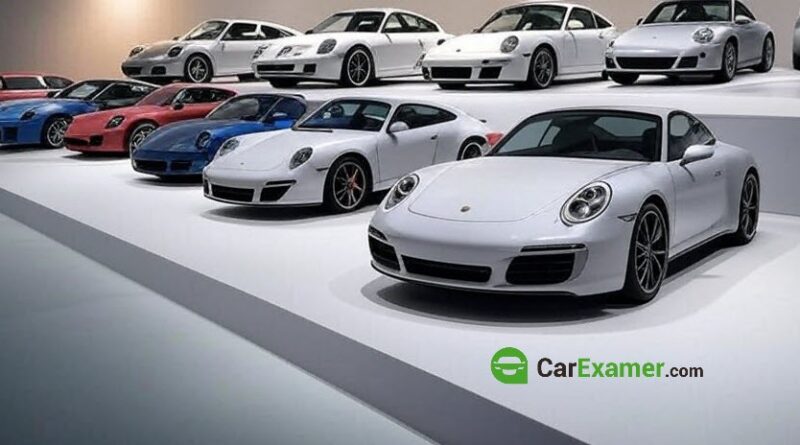The Complete History of the Porsche 911: Generations 1964-2025
The Porsche 911 is more than just a car; it’s a legacy. Launched in 1964, the 911 has become one of the most iconic and enduring sports cars in automotive history. Each generation brings its own innovations while staying true to the rear-engine, flat-six formula that made the original a legend. In this guide, we’ll take a detailed look at every Porsche 911 generation, its model variants, and engine sizes from the classic air-cooled era to the modern turbocharged supercars.

1. Porsche 911 (1964 to 1989) – The Classic Air-Cooled Era
Known as: “Original 911” and “G-Model”
Body Style: Coupe, Targa, Cabriolet
Engine sizes:
- 2.0L Flat-6 (1964 to 1969)
- 2.2L (1970 to 1971)
- 2.4L (1972 to 1973)
- 2.7L (1974 to 1977)
- 3.0L (1978 to 1983)
- 3.2L (1984 to 1989)
Notable models:
- 911T, 911E, 911S (early years)
- 911 Carrera RS 2.7 (1973)
- 911 Turbo 3.0 (1975)
- 911 SC, Carrera 3.2 (late G-Series)
Key Features: Air-cooled engine, lightweight build, no electronic aids

2. Porsche 964 (1989 to 1994) – The Modernisation Begins
Body Style: Coupe, Targa, Cabriolet, Turbo
Engine sizes:
- 3.6L Flat-6 (Carrera 2 and 4)
- 3.3L Turbo
- 3.6L Turbo (Turbo 3.6)
Notable models: Carrera 2, Carrera 4, 964 Turbo, 964 RS
Key Features: First 911 with ABS, power steering, airbags, and optional Tiptronic

3. Porsche 993 (1994 to 1998) – The Last Air-Cooled 911
Body Style: Coupe, Cabriolet, Targa, Turbo
Engine sizes:
- 3.6L Flat-6 naturally aspirated
- 3.6L Twin-Turbo (Turbo)
Notable models: Carrera, Carrera 4, Carrera 4S, Turbo, RS, GT2
Key Features: Last air-cooled engine, redesigned suspension, wide-body design

4. Porsche 996 (1998 to 2004) – The Water-Cooled Revolution
Body Style: Coupe, Cabriolet, Targa
Engine sizes:
- 3.4L Flat-6 (1998 to 2001)
- 3.6L Flat-6 (2002 to 2004)
- 3.6L Twin-Turbo (Turbo)
Notable models: Carrera, Carrera 4, 4S, Turbo, GT2, GT3
Key Features: First water-cooled 911, shared parts with Boxster, unique headlights

5. Porsche 997 (2005 to 2012) – The Return of the Classic Look
Body Style: Coupe, Cabriolet, Targa
Engine sizes:
- 3.6L Flat-6 (Carrera)
- 3.8L Flat-6 (Carrera S, GTS, GT3)
- 3.6L / 3.8L Twin-Turbo (Turbo, Turbo S)
Notable models: Carrera, GTS, Turbo, GT3, GT2 RS
Key Features: Classic round headlights return, improved handling and electronics

6. Porsche 991 (2012 to 2019) – Longer, Wider, Faster
Body Style: Coupe, Cabriolet, Targa
Engine sizes:
- 3.4L Flat-6 (early Carrera)
- 3.8L Flat-6 (Carrera S, GTS, GT3)
- 3.0L Twin-Turbo (from 2016 facelift)
- 3.8L Twin-Turbo (Turbo and Turbo S)
- 4.0L naturally aspirated Flat-6 (GT3 RS)
Notable models: Carrera, Carrera S, GTS, Turbo, Turbo S, GT3, GT2 RS
Key Features: Turbocharging on Carrera range, lighter and more rigid chassis

7. Porsche 992 (2019 to Present) – The Tech-Heavy Era
Body Style: Coupe, Cabriolet, Targa
Engine sizes:
- 3.0L Twin-Turbo Flat-6 (Carrera, Carrera S, GTS)
- 3.7L Twin-Turbo (Turbo, Turbo S)
- 4.0L naturally aspirated Flat-6 (GT3, GT3 RS)
Notable models: Carrera, GTS, Turbo, GT3, GT3 RS, Targa, Dakar, S/T
Key Features: Digital dashboard, hybrid development underway, widebody as standard
Final Thoughts
The Porsche 911 has evolved across more than 60 years but has never lost its soul. Whether you prefer the charm of a classic air-cooled model or the technology of the modern turbocharged variants, there is a 911 for every enthusiast. Know your generation, understand the engines, and make the right choice for your lifestyle.
For buyers considering a used 911, a professional inspection from CAREXAMER can save thousands in future repairs and provide peace of mind before purchase.
Buying a used VW. Buying used vauxhall, BMW, Jaguar, Ford, Volvo, Range rover, Bentley, Aston Martin, Porsche, Ferrari, Lamborghini, Maserati, Hyundai, Tesla, Honda, Pagani

